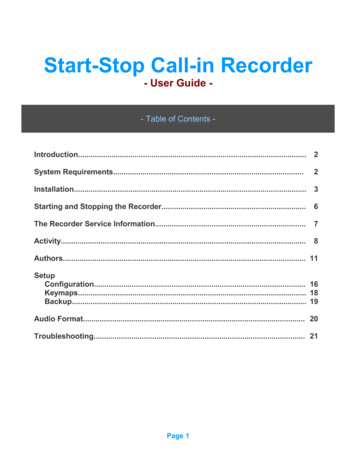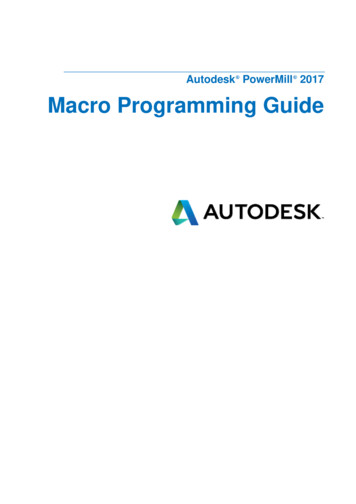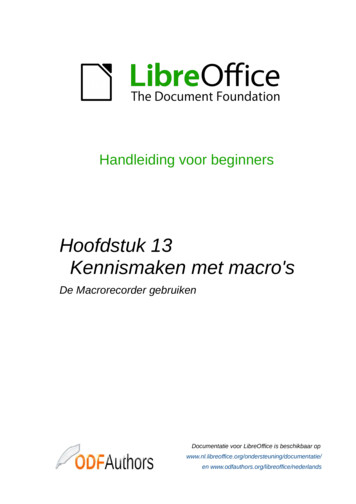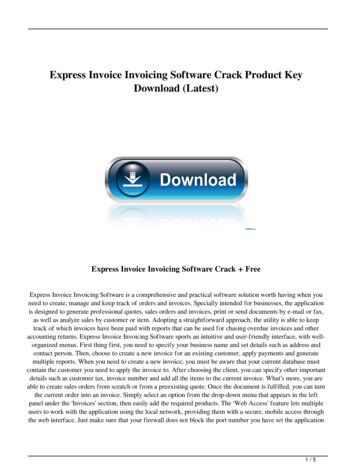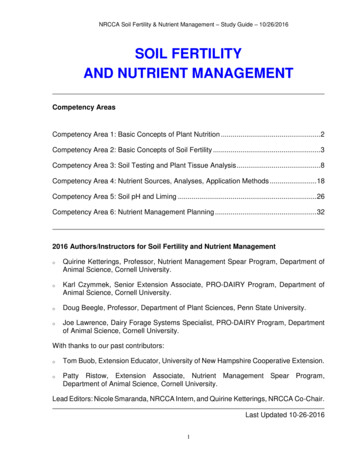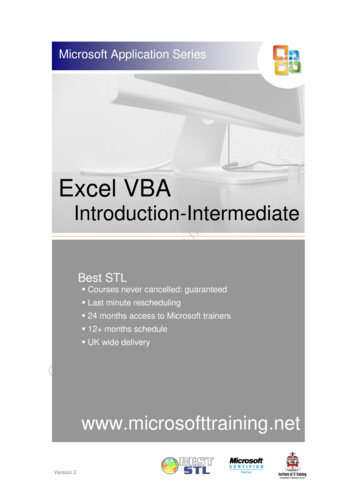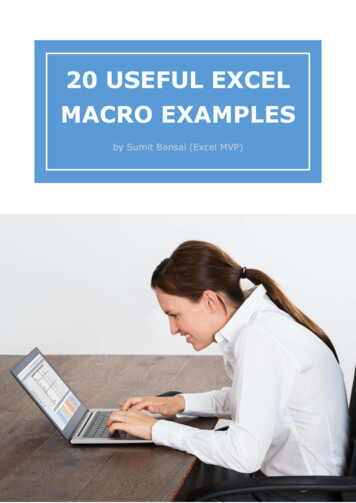
Transcription
Getting Started GuideChapter 13Getting Started with MacrosUsing the Macro Recorder and Beyond
CopyrightThis document is Copyright 2010–2012 by its contributors as listed below. You may distribute itand/or modify it under the terms of either the GNU General Public License(http://www.gnu.org/licenses/gpl.html), version 3 or later, or the Creative Commons AttributionLicense (http://creativecommons.org/licenses/by/3.0/), version 3.0 or later.All trademarks within this guide belong to their legitimate owners.ContributorsRon Faile Jr.Martin FoxAndrew PitonyakFeedbackPlease direct any comments or suggestions about this document entsThis chapter is based on Chapter 13 of Getting Started with OpenOffice.org 3.3. The contributorsto that chapter are:Andrew PitonyakJean Hollis WeberPublication date and software versionPublished 26 July 2012. Based on LibreOffice 3.5.Note for Mac usersSome keystrokes and menu items are different on a Mac from those used in Windows and Linux.The table below gives some common substitutions for the instructions in this chapter. For a moredetailed list, see the application Help.Windows or LinuxMac equivalentEffectTools Options menuselectionLibreOffice PreferencesAccess setup optionsRight-clickControl clickOpens a context menuCtrl (Control)z (Command)Used with other keysF5Shift z F5Opens the NavigatorF11z TOpens the Styles and Formatting windowDocumentation for LibreOffice is available at http://www.libreoffice.org/get-help/documentation
ContentsCopyright. 2Note for Mac users.2Your first macros.4Adding an existing macro. 4Creating a simple macro. 5Running the macro. 7Viewing and editing the macro. 7Comments start with REM. 8Defining subroutines with SUB. 8Defining variables using DIM. 8Pulling the macro together. 8Creating a macro.9A complicated example. 9Running the macro quickly. 12Sometimes the macro recorder fails.13The dispatch framework. 13How the macro recorder uses the dispatch framework. 13Other options. 13Macro organization. 14Where are macros stored?. 16Importing macros. 16Downloading macros to import. 17How to run a macro.18Toolbar. 19Menu item. 19Keyboard shortcuts. 19Event. 20Extensions. 22Writing macros without the recorder. 22Finding more information. 23Included material. 23Online resources. 23Printed and eBook materials. 24Getting Started with Macros3
Your first macrosA macro is a saved sequence of commands or keystrokes that are stored for later use. An exampleof a simple macro is one that “types” your address. The LibreOffice macro language is veryflexible, allowing automation of both simple and complex tasks. Macros are especially useful torepeat a task the same way over and over again.LibreOffice macros are usually written in a language called LibreOffice Basic, or just abbreviatedBasic. Although you can learn Basic and write macros, there is a steep learning curve to writingmacros from scratch. The usual methods for a beginner are to add macros that someone else haswritten and to use the built-in macro recorder, which records your keystrokes and saves them foruse.In LibreOffice recording of macros is currently classified as an “experimental (unstable)” feature. Toenable macro recording, use Tools Options LibreOffice General and select the Enableexperimental (unstable) features option.Figure 1: Enable macros in the Options dialog.Most tasks in LibreOffice are accomplished by “dispatching a command” (sending a command),which is intercepted and used. The macro recorder works by recording the commands that aredispatched (see “The dispatch framework” on page 13).Adding an existing macroThe first step in learning macro programming is to find and use existing macros. This sectionassumes that you have a macro that you want to use; the macro may be in an email, on a webpage, or even in a book. For this example, use the macro in Listing 1.Listing 1: Simple macro that says hello.Sub HelloMacroPrint "Hello"End Sub4Getting Started with Macros
You must create a library and module to contain your macro; this is covered in “Macroorganization” on page 14. Use these steps to create a library to contain your macro:1) Use Tools Macros Organize Macros LibreOffice Basic to open the Macro dialog(see Figure 2 and Figure 7).2) Click Organizer to open the Basic Macro Organizer dialog (see Figure 8).3) Select the Libraries tab.4) Set the Location to My Macros & Dialogs, which is the default.5) Click New to open the New Library dialog. Enter a library name such as “TestLibrary” andclick OK.6) Select the Modules tab.7) In the Module list, expand My Macros and select TestLibrary. A module named Module1already exists and can contain your macro. You can click New to create another module inTestLibrary.8) Select the Module1, or the new module that you created, and click Edit to open theIntegrated Debugging Environment (IDE).9) The IDE is a text editor for macros that allows you to edit and create macros. Copy themacro into the IDE.When a new module is created, it contains a comment and an empty macro named Main, thatdoes nothing.Listing 2: Contents of Module1 after it is created.REM*****BASIC*****Sub MainEnd SubAdd the new macro either before Sub Main or after End Sub. In Listing 3, the new macro has beenadded before Sub Main.Listing 3: Module1 after adding the new macro.REM*****BASIC*****Sub HelloMacroPrint "Hello"End SubSub MainEnd SubClick the Run Basic buttonin the toolbar, or press F5, to run the first macro in the module. Usethe Macro dialog, opened using the Select macro buttonor Tools Macros OrganizeMacros LibreOffice Basic, to select and run any macro in the module.Creating a simple macroImagine repeatedly entering simple information. Although you can store the information in theclipboard, if you use the clipboard for something else, the contents are changed. Storing thecontents as a macro is a simple solution. (In some simple cases, including the example used here,a better solution is to use AutoText.)Your first macros5
1) Use Tools Macros Record Macro to start recording a macro.A small window is displayed so you know that LibreOffice is recording.2) Type the desired information or perform an appropriate series ofoperations. In this case, I typed the name, Andrew Pitonyak.3) Click the Stop Recording button to stop recording, save the macro, and display theLibreOffice Basic Macros dialog.MacrosLibrary ContainersLibrariesModulesFigure 2: LibreOffice Macro Organizer dialog, Writer module selectedTipThe buttons in the Macro Organizer dialog differ depending on what is selected inthe (see Figure 2 and Figure 7).4) Be certain to open the library container named My Macros. Find the library namedStandard under My Macros. Be warned, every library container has a library namedStandard. Select the Standard library and click New Module to create a new module tocontain the macro.5) The default module name is Module1. Type a descriptive name and click OK to create themodule. The LibreOffice Basic Macros dialog is displayed again, showing the new module.Figure 3: Give your module a meaningful name6) Highlight the newly created module. In the upper left corner, type the macro name to use,such as “EnterMyname”, and then click Save to save the macro.If you followed all of the steps, the Standard library now contains a module named Recorded,which contains the EnterMyName macro, as shown in Figure 4.Note6When LibreOffice creates a new module, it automatically adds the macro namedMain.Getting Started with Macros
Running the macroUse Tools Macros Run Macro to open the Macro Selector dialog. Select the newly createdmacro and click Run.Figure 4: Select a macro and click RunThere are other methods to run a macro. For example, use Tools Macros Organize Macros LibreOffice Basic to open the LibreOffice Basic Macros dialog, which contains a Run button aswell.Viewing and editing the macroYou can view and edit the macro that was just created. Use Tools Macros Organize Macros LibreOffice Basic to open the LibreOffice Basic Macros dialog (see Figure 4). Select the newmacro and click Edit to open the macro in the Basic IDE (Integrated Development Environment).Listing 4: Generated “EnterMyname” macro.REM *****Sub MainBASIC*****End Subsub EnterMyNamerem ----------rem define variablesdim documentas objectdim dispatcher as objectrem ----------rem get access to the documentdocument ThisComponent.CurrentController.Framedispatcher r")rem ----------dim args1(0) as new com.sun.star.beans.PropertyValueargs1(0).Name "Text"args1(0).Value "Andrew Pitonyak"dispatcher.executeDispatch(document, ".uno:InsertText", "", 0, args1())end subYour first macros7
The macro in Listing 4 is not as complicated as it first appears. Learning a few things helpssignificantly in understanding the generated macros. The discussion starts with features near thetop of the macro listing and describes them. If you like to avoid details, then simply change the text“Andrew Pitonyak” in the macro above to what you want to insert at the current cursor position.Comments start with REMThe keyword REM, short for remark, starts a macro comment. All text after REM (on the same line)is ignored. As a short cut, the single quote character can also be used to start a comment.TipLibreOffice Basic is not case-sensitive for keywords, so REM, Rem, and rem all starta comment. If you use symbolic constants defined by the API, it is safer to assumethat the names are case-sensitive—symbolic constants are an advanced topic notusually needed by people that use the macro recorder.Defining subroutines with SUBIndividual macros are stored in subroutines defined with the keyword SUB. The end of a subroutineis indicated by the words END SUB. The code starts by defining the subroutine named Main, whichis empty and does nothing. The next subroutine, EnterMyName, contains the generated code.TipLibreOffice always creates an empty subroutine named Main when it creates amodule.There are advanced topics that are beyond the scope of this document, but knowing about themmight be of interest: You can write a macro so that values can be passed to the subroutine. The values arecalled arguments. Recorded macros do not accept arguments. Another kind of subroutine is called a function. A function is a subroutine that returns avalue. The keyword FUNCTION is used rather than SUB to define a function. Generatedmacros are always of type SUB.Defining variables using DIMYou can write information on a piece of paper so that you can look at it later. A variable, like a pieceof paper, contains information that can be changed and read. The DIM statement is similar tosetting aside a piece of paper to be used to store a message or note.The EnterMyName macro defines the variables document and dispatcher as type object. Othercommon variable types include string, integer, and date. A third variable, named args1, is an arrayof property values. A variable of type array allows a single variable to contain multiple values,similar to storing multiple pages in a single book. Values in an array are usually numbered startingfrom zero. The number in the parentheses indicates the highest usable number to access astorage location. In this example, there is only one value, and it is numbered zero.Pulling the macro togetherThe following details are very complete; it is not important to understand all of the details. The firstline defines the start of the macro.sub EnterMyNameDeclare two variables:dim documentas objectdim dispatcher as object8Getting Started with Macros
ThisComponent refers to the current document.The CurrentController property of a document refers to a service that “controls” the document. Forexample, when you type, it is the current controller that notices. The current controller thendispatches the changes to the document’s frame.The Frame property of a controller returns a main frame for a document. Therefore, the variablenamed document refers to a document’s frame, which receives dispatched commands.document ThisComponent.CurrentController.FrameMost tasks in LibreOffice are accomplished by dispatching a command. LibreOffice includes adispatch helper service, which does most of the work to use dispatches in macros. The methodCreateUnoService accepts the name of a service and it tries to create an instance of that service.On completion, the dispatcher variable contains a reference to a DispatchHelper.dispatcher r")Declare an array of properties. Each property has a name and a value. In other words, it is aname/value pair. The created array has one property at index zero.dim args1(0) as new com.sun.star.beans.PropertyValueGive the property the name “Text” and the value “Andrew Pitonyak”, which is the text that isinserted when the macro is run.args1(0).Name "Text"args1(0).Value "Andrew Pitonyak"This is where the magic happens. The dispatch helper sends a dispatch to the document’s frame(stored in the variable named document) with the command .uno:InsertText. The next twoarguments, frame name and search flags, are beyond the scope of this document. The lastargument is the array of property values to be used while executing the command InsertText.dispatcher.executeDispatch(document, ".uno:InsertText", "", 0, args1())Finally, the end of the subroutine.end subCreating a macroWhen creating a macro, it is important to ask two questions before recording:1) Can the task be written as a simple set of commands?2) Can the steps be arranged such that the last command leaves the cursor ready for the nextcommand?A complicated exampleI frequently copy rows and columns of data from a web site and format them as a table in a textdocument. First, I copy the table from the web site to the clipboard. To avoid strange formatting andfonts, I paste the text into a Writer document as unformatted text. I reformat the text with tabsbetween columns so that I can use Table Convert Text to Table to convert to a table.I inspect the text to see if I can record a macro to format the text (remember the two questions thatI ask). As an example, I copied the FontWeight constants group from the API web site. The firstcolumn indicates the constant name. Each name is followed by a space and a tab.Creating a macro9
DONTKNOWThe font weight is not specified/known.THINspecifies a 50% font weight.ULTRALIGHTspecifies a 60% font weight.LIGHTspecifies a 75% font weight.SEMILIGHTspecifies a 90% font weight.NORMALspecifies a normal font weight.SEMIBOLDspecifies a 110% font weight.BOLDspecifies a 150% font weight.ULTRABOLDspecifies a 175% font weight.BLACKspecifies a 200% font weight.I want the first column to contain the numeric value, the second column the name, and the thirdcolumn the description. The desired work is easily accomplished for every row except forDONTKNOW and NORMAL, which do not contain a numeric value—but I know that the values are0 and 100, so I will enter those manually.The data can be cleaned in multiple ways—all of them easy. The first example uses keystrokesthat assume the cursor is at the start of the line with the text THIN.1)2)3)4)5)6)7)8)9)10)11)12)13)14)15)16)17)Use Tools Macros Record Macro to start recording.Press Ctrl Right Arrow to move the cursor to the start of “specifies”.Press Backspace twice to remove the tab and the space.Press Tab to add the tab without the space after the constant name.Press Delete to delete the lower case s and then press S to add an upper case S.Press Ctrl Right Arrow twice to move the cursor to the start of the number.Press Ctrl Shift Right Arrow to select and move the cursor before the % sign.Press Ctrl C to copy the selected text to the clipboard.Press End to move the cursor to the end of the line.Press Backspace twice to remove the two trailing spaces.Press Home to move the cursor to the start of the line.Press Ctrl V to paste the selected number to the start of the line.Pasting the value also pasted an extra space, so press Backspace to remove the extraspace.Press Tab to insert a tab between the number and the name.Press Home to move to the start of the line.Press down arrow to move to the next line.Stop recording the macro and save the macro.It takes much longer to read and write the steps than to record the macro. Work slowly and thinkabout the steps as you do them. With practice this becomes second nature.The generated macro has been modified to contain the step number in the comments to match thecode to the step above.10Getting Started with Macros
Listing 5: Copy the numeric value to the start of the column.sub CopyNumToCol1rem ----------rem define variablesdim documentas objectdim dispatcher as objectrem ----------rem get access to the documentdocument ThisComponent.CurrentController.Framedispatcher r")rem (2) Press Ctrl Right Arrow to move the cursor to the start of t, ".uno:GoToNextWord", "", 0, Array())rem (3) Press Backspace twice to remove the tab and the space.dispatcher.executeDispatch(document, ".uno:SwBackspace", "", 0, Array())rem ----------dispatcher.executeDispatch(document, ".uno:SwBackspace", "", 0, Array())rem (4) Press Tab to add the tab without the space after the constant name.dim args4(0) as new com.sun.star.beans.PropertyValueargs4(0).Name "Text"args4(0).Value CHR (9)dispatcher.executeDispatch(document, ".uno:InsertText", "", 0, args4())rem (5) Press Delete to delete the lower case s .dispatcher.executeDispatch(document, ".uno:Delete", "", 0, Array())rem (5) . and then press S to add an upper case S.dim args6(0) as new com.sun.star.beans.PropertyValueargs6(0).Name "Text"args6(0).Value "S"dispatcher.executeDispatch(document, ".uno:InsertText", "", 0, args6())rem (6) Press Ctrl Right Arrow twice to move the cursor to the number.dispatcher.executeDispatch(document, ".uno:GoToNextWord", "", 0, Array())rem ----------dispatcher.executeDispatch(document, ".uno:GoToNextWord", "", 0, Array())rem (7) Press Ctrl Shift Right Arrow to select the number.dispatcher.executeDispatch(document, ".uno:WordRightSel", "", 0, Array())rem (8) Press Ctrl C to copy the selected text to the clipboard.dispatcher.executeDispatch(document, ".uno:Copy", "", 0, Array())rem (9) Press End to move the cursor to the end of the line.dispatcher.executeDispatch(document, ".uno:GoToEndOfLine", "", 0, Array())rem (10) Press Backspace twice to remove the two trailing spaces.dispatcher.executeDispatch(document, ".uno:SwBackspace", "", 0, Array())Creating a macro11
rem ----------dispatcher.executeDispatch(document, ".uno:SwBackspace", "", 0, Array())rem (11) Press Home to move the cursor to the start of the line.dispatcher.executeDispatch(document, ".uno:GoToStartOfLine", "", 0, Array())rem (12) Press Ctrl V to paste the selected number to the start of the line.dispatcher.executeDispatch(document, ".uno:Paste", "", 0, Array())rem (13) Press Backspace to remove the extra space.dispatcher.executeDispatch(document, ".uno:SwBackspace", "", 0, Array())rem (14) Press Tab to insert a tab between the number and the name.dim args17(0) as new com.sun.star.beans.PropertyValueargs17(0).Name "Text"args17(0).Value CHR (9)dispatcher.executeDispatch(document, ".uno:InsertText", "", 0, args17())rem (15) Press Home to move to the start of the line.dispatcher.executeDispatch(document, ".uno:GoToStartOfLine", "", 0, Array())rem (16) Press Down Arrow to move to the next line.dim args19(1) as new com.sun.star.beans.PropertyValueargs19(0).Name "Count"args19(0).Value 1args19(1).Name "Select"args19(1).Value falsedispatcher.executeDispatch(document, ".uno:GoDown", "", 0, args19())end subCursor movements are used for all operations (as opposed to searching). If run on theDONTKNOW line, the word weight is moved to the front of the line, and the first “The” is changedto “She”. This is not perfect, but I should not have run the macro on the lines that did not have theproper format; I need to do these manually.Running the macro quicklyIt is tedious to repeatedly run the macro using Tools Macros Run Macro (see Figure 4). Themacro can be run from the IDE. Use Tools Macros Organize Macros LibreOffice Basic toopen the Basic Macro dialog. Select your macro and click Edit to open the macro in the IDE.The IDE has a Run Basic icon in the toolbar that runs the first macro in the IDE. Unless youchange the first macro, it is the empty macro named Main. Modify Main so that it reads as shown inListing 6.Listing 6: Modify Main to call CopyNumToCol1.Sub MainCopyNumToCol1End SubNow, you can run CopyNumToCol1 by repeatedly clicking the Run Basic icon in the toolbar of theIDE. This is very fast and easy, especially for temporary macros that will be used a few times andthen discarded.12Getting Started with Macros
Sometimes the macro recorder failsUnderstanding the LibreOffice internals helps to understand how and why the macro recorderfrequently fails. The primary offender is related to the dispatch framework and its relationship to themacro recorder.The dispatch frameworkThe purpose of the dispatch framework is to provide uniform access to components (documents)for commands that usually correspond to menu items. I can use File Save from the menu, theshortcut keys Ctrl S, or click on the Save toolbar icon. All of these commands are translated intothe same “dispatch command”.The dispatch framework can also be used to send “commands” back to the UI (User Interface). Forexample, after saving the document, the File Save command is disabled. As soon as the documenthas been changed, the File Save command is enabled.If we see a dispatch command, it is text such as .uno:InsertObject or .uno:GoToStartOfLine. Thecommand is sent to the document’s frame, and the frame passes on the command until an objectis found that can handle the command.How the macro recorder uses the dispatch frameworkThe macro recorder records the generated dispatches. The recorder is relatively simple toimplement and the same commands that are issued are recorded for later use. The problem is thatnot all dispatched commands are complete. For example, inserting an object generates thefollowing code:dispatcher.executeDispatch(document, ".uno:InsertObject", "", 0, Array())It is not possible to specify what kind of object to create or insert. If an object is inserted from a file,you cannot specify which file to insert.I recorded a macro and used Tools Options to open and modify configuration items. Thegenerated macro does not record any configuration changes; in fact, the generated code iscommented so it will not even be run.rem reeDialog", "", 0, Array())If a dialog is opened, the command to open the dialog is likely to be generated. Any work doneinside the dialog is not usually recorded. Examples include macro organization dialogs, insertingspecial characters, and similar types of dialogs. Other possible problems using the macro recorderinclude things such as inserting a formula, setting user data, setting filters in Calc, actions indatabase forms, and exporting a document to an encrypted PDF file. You never know for certainwhat will work unless you try it, however. The actions from the search dialog are properly captured,for example.Other optionsWhen the macro recorder is not able to solve a specific problem, the usual solution is to write codeusing the LibreOffice objects. Unfortunately, there is a steep learning curve for the objects. It isusually best to start with simple examples and then branch out slowly as you learn more. Learningto read generated macros is a good place to start.If you record Calc macros, and the recorder can correctly generate a macro, there is an add-increated by Paolo Mantovani, which converts Calc macros when they are recorded. The final codemanipulates LibreOffice objects rather than generating dispatches. This can be very useful forlearning the object model.Sometimes the macro recorder fails13
You can download the macro recorder from Paolo’s web site DispatchToApiRecorder/Macro organizationIn LibreOffice, macros are grouped in modules, modules are grouped in libraries, and libraries aregrouped in library containers. A library is usually used as a major grouping for either an entirecategory of macros, or for an entire application. Modules usually split functionality, such as userinteraction and calculations. Individual macros are subroutines and functions.Figure 5: Macro Library hierarchyA computer scientist would use Figure 6 to precisely describe the situation. The text “1.*” meansone or more, and “0.*” means zero or more. The black triangle means composed of or contains. A library container contains one or more libraries, and each library is contained in onelibrary container. A library contains zero or more modules, and each module is contained in one library. A module contains zero or more macros, and each macro is contained in one module.Figure 6: Macro Library hierarchyUse Tools Macros Organize Macros LibreOffice Basic to open the LibreOffice BasicMacros dialog (see Figure 7). All available library containers are shown in the Macro from list.Every document is a library container, capable of containing multiple libraries. The application itselfacts as two library containers, one container for macros distributed with LibreOffice calledLibreOffice Macros, and one container for personal macros called My Macros. As shown in Figure7, only two documents are currently open.14Getting Started with Macros
Figure 7: Library containers are shown on the leftThe LibreOffice Macros are stored with the application runtime code, which may not be editable toyou unless you are an administrator. This is just as well since these macros should not be changedand you should not store your own macros in
A macro is a saved sequence of commands or keystrokes that are stored for later use. An example of a simple macro is one that "types" your address. The LibreOffice macro language is very flexible, allowing automation of both simple and complex tasks. Macros are especially useful to repeat a task the same way over and over again.


